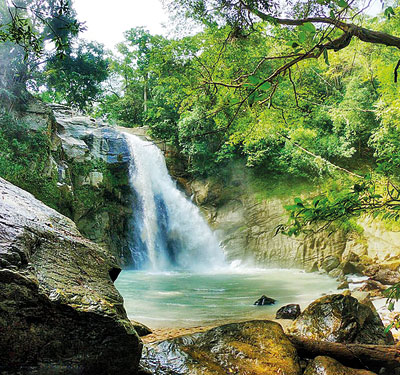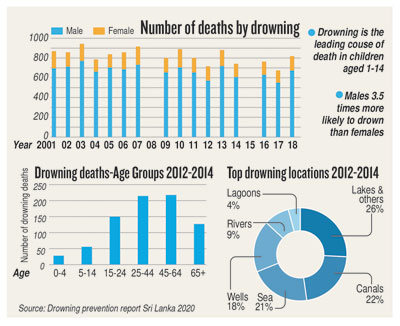News
Drowning deaths fears resurface in wake of inland travel resumption
Deaths by drowning are likely to increase after travel between provinces were lifted and inter-provincial train services resumed this weekand holidaymakers rushed to beaches, waterfalls, lakes, reservoirs, and other inland waterways, professionals involved in water safety fear.
This is also a season of heavy downpours.
Recently, three members of a family from Kattankudy died at Elle Wala waterfall in Wellawaya. Mohammad Niyas, 38, drowned along with his son Sameem, 15, and eldest daughter Fathima, 11. Attempts to resuscitate them had failed.

Elle Wala waterfall in Wellawaya
Now, access to the waterfall to local and foreign tourists has been restricted by the Wellawaya Pradeshiya Sabha. This tourist attraction has claimed six
lives, so far.
Wellawaya Pradeshiya Sabha chairman, R.D. Haramanis said two divers will be employed as lifeguards and that a fence will be erected. An observation post and two stalls will also be erected to store emergency equipment and for use as sanitary facilities.
Asanka Nanayakkara, president of Sri Lanka Life Saving, said about 75 percent of drowning deaths take place in inland waterways. The Drowning Prevention Report of 2020, says that among the leading drowning locations, 26 percent are lakes and others, 22 percent are canals, 21 percent drown at sea, and 18 percent drown in wells.
“When the Central hills receive heavy rains, it is reflected in water levels of waterfalls and rivers. Even lifeguards find it extremely hard to save those drowning in waterfalls or rivers, as a rush of water can also carry rocks, broken branches that can cause fatal injuries, while muddy water with soil can lead to choking. The best is to avoid getting into deep waters, or any water source during the wet weather. A sudden increase in water flow is dangerous,” he warned.
Drowning is considered the second highest cause of accidental death in the country, with more than 750 dying every year.
He said a majority of young people had lost their lives while getting into the water under the influence of alcohol.
Among several drowning deaths this year was a 62-year-old man and his six-year-old twin grandchildren who died off Kosgoda while practicing to swim. The three youths drowned in a reservoir in Buttala.
Mr Nanayakkara said if the waters in coastal areas are turbulent, swimming could be dangerous as unforeseen currents could dash a person against the rock and reef. A number of people, including foreigners were rescued in Mt. Lavinia last week, he said.
“Lifeguards, signage, and lifesaving kits or floating equipment, should be compulsory if the country is planning to promote tourism. Local authorities who are mostly in charge of inland tourist waterfronts should do more to protect those who come to enjoy, not only concentrate on the income they generate,” he said.
Mr. Nanayakkara said drowning is the leading cause of death in children between the ages of one to 14 in the country. About 100 children die from drowning every year.
The director of the Police Life Saving Unit, Senior Superintendent of Police Priyankara de Silva told the Sunday Times that there are plans to post more police life-savers and strengthen the century-old Police Life Saving Unit.
“There are about 300 police life-savers. I have requested to add 300 more well-trained lifeguards for coastal areas
and inland water attractions,”
he said.
“Public awareness of water safety is a must. If one has no idea of water safety and does not know how to swim, getting into the water is a risk. Unfortunately, people get into the water ignoring warning signs, or flags.’’
He also said people who gather at crowded sites without wearing face masks could spread Covid-19.
Additional reporting and pic by Moneragala Correspondent Sumanasiri Gunathilake


